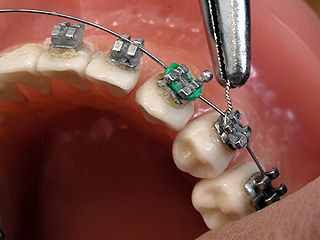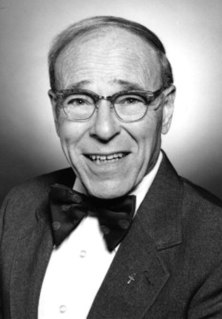
Orthodontics is a dentistry specialty that addresses the diagnosis, prevention, management, and correction of mal-positioned teeth and jaws, and misaligned bite patterns. It may also address the modification of facial growth, known as dentofacial orthopedics.
The Canadian Association of Orthodontists, founded in 1949, is the Canadian national organization of educationally qualified orthodontic specialists. Its headquarters are in Markham, Ontario.
The Consultant Orthodontists Group (COG) is a group which represents consultant orthodontists in the United Kingdom the COG was established in 1964 to represent consultant orthodontists working in the hospital service and the membership was limited to orthodontists holding consultant contracts in the National Health Service. Relationships with oral surgeons was a particular concern of the group in the early years and although it was primarily a political organisation, the COG held clinical and political meetings biannually and attendance was restricted to members of the group. It has established strong links with the Royal Surgical Colleges and the British Dental Association (BDA) through it representatives on the BDA Central Committee for Hospital Dental Services (CCHDS) and was often regarded as the political voice of orthodontists. Almost all members of the group were members of the British Society for the Study of Orthodontics (BSSO) and about 70 members belonged to the British Association of Orthodontists (BAO) as well.
Harold Gladstone Watkin, known by many of his contemporaries as "Watty", is considered one of the most pioneering English orthodontists of the early 20th Century.
David Domenic Di Biase (1935–2001) was a British dentist. He was best known for developing, together with Arthur Levis (1927–2000), Chief Dental Technician at Southend General Hospital, the Southend Clasp, a widely used retention component used on removable orthodontic appliances.
Ernest Sheldon Friel, was an Irish dentist who was the first specialist orthodontist to practise in the United Kingdom of Great Britain and Ireland, and the second in Europe, going on to become the first Professor of Orthodontics in Europe. His obituary in The Journal of the Irish Dental Association described him as the most distinguished dentist that Ireland had ever produced.

Dr. Ravindra Nanda is a professor and Head of the Department of Craniofacial Sciences and Chair of the Division of Orthodontics at the University of Connecticut School of Dental Medicine. He is part of the founding faculty of School of Dental Medicine and has been at the University of Connecticut since 1972 where he also holds an Alumni Chair in the Orthodontics Division. He is an innovator of various appliances in orthodontics. His research and clinical interests include adolescent and adult orthodontics, the biology of tooth mobility, craniofacial orthopedics, biomechanics and developing efficient mechanics to deliver orthodontic care.
Indian Orthodontic Society is a professional association for orthodontists that was started in 1965 in Mumbai, India.
Charles J. Burstone was an American orthodontist who was notable for his contributions to biomechanics and force-systems in the field of orthodontics. He was well known for co-development of new orthodontic material such as beta titanium, nickel titanium, and long fiber-reinforced composite. He wrote more than 200 articles in scientific fields.
Charles Henry Tweed was an American orthodontist known for many of his contributions to the field of orthodontics. He was a founder of the Charles H. Tweed Foundation for Orthodontic Research. Tweed a student of Edward Angle in Pasadena, California and a classmate of Raymond Begg.
Albert H. Ketcham was an American orthodontist and a past president of the American Society of Orthodontists.
David L. Turpin is an American orthodontist who was the editor-in chief for The Angle Orthodontist from 1988 to 1999 and American Journal of Orthodontics and Dentofacial Orthopedics from 1999 to 2010.

T. M. "Tom" Graber was an American orthodontist known for his contributions to the field of orthodontics. Graber wrote 28 books on orthodontics and dental anatomy. He also wrote chapters in more than 20 books and over 175 published articles.
Jacob Amos Salzmann (1901–1992) was an American orthodontist who is known for developing an assessment index for determining malocclusion. This index has been adopted by ADA Council of Dental Health, the Council on Dental Care Programs, and by the American Association of Orthodontists.
International Orthodontic Congress is a meeting held every five years where world's leading Orthodontists and allied professionals come together to discuss Orthodontic related topics. The first meeting was held in 1926 in New York City, US, and has had 8 meetings happen in its 90-year history. This is an official meeting of World Federation of Orthodontists (WFO).
George Northcroft was a British orthodontist who is known for his contributions in the formation of the British Orthodontic Society. The society was initially formed in 1907 as British Society for the Study of Orthodontics (BSSO) and the name later changed to British Orthodontic Society. He also played an important role in formation of the Dental Act of 1921 which made dentistry a profession in Great Britain.
Harold Chapman was a British orthodontist who was England's first exclusive orthodontic practitioner in 1921. He was also the President of the European Orthodontic Society and British Dental Association during his career.
Clifford Ballard was a British orthodontist. He became England's first Professor of Orthodontics in 1956. He served as the President of BSSO in 1957.
John Hooper was a British orthodontist who was appointed as the first Dental Consultant in Orthodontics of the National Health Services of Britain to the Wessex Regional Health Board.

The Orthodontic Technicians Association (UK) (OTA) is the professional body that represents orthodontic technologists, based in the United Kingdom.


